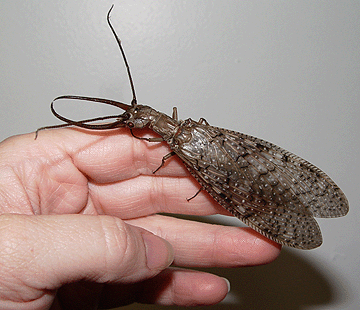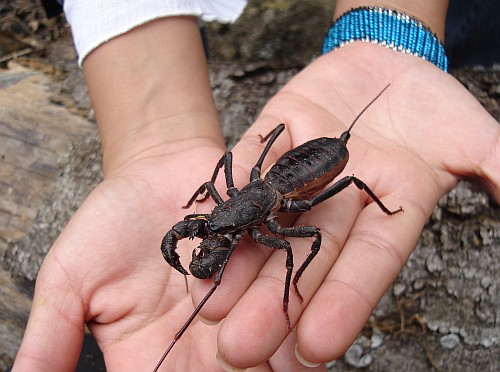#5 - The Dobsonfly
The Dobsonfly is a family of water fly that can be found in the Americas and Asia. They live near rivers and springs and their aquatic larvae are used as fishing bait. Aside from being attracted to porch lights, they are usually of little consequence to humans. In fact, most people can live in Dobsonfly-inhabited areas and never know.
 |
| A female Asian Dobsonfly via Wikimedia Commons |
But as the saying goes, everything is bigger in Texas. In the case of the Dobsonfly, much bigger. The Texan Dobsonfly, Corydalus texanus, measure around 4 inches long, from the tips of their pincers to the ends of their long, veiny wings. Some male specimens can reach 5 inches or more. The males of the species also have long, thin pincers that are used in mating and presumably, nightmaring. The first time I ever saw one of these was in a swampy state park public bathroom. Their wings sound more like the flapping of a bat than the buzzing of a fly, and my screams sounded more like a dying horse than a little girl's. I was eventually able to carry it out on a hat so that I could try to pee in peace, but relief did not come easy.
 |
| Corydalus texanus via SarahMBruce |
 |
| And an unfortunate size comparison |
Yeah. That's it. And that's only #5.
#4 - The Giant Water Bug
"Water bug" is a broad term for the many species of insects that live in our lakes and ponds, and also a more specific term referring to a family of shield-shaped carnivorous insects. But there is only one Giant Water Bug. Lethocerus americanus can be found in the waters of Houston, and can get up to three inches long. In addition to their gruesome claws and their weird, alien heads, they also have sharp, beak-like mandibles and insect-liquefying venom. After biting their prey they let them turn to mush inside their own skin before eating them at their leisure. Their bite is also quite painful to humans, gaining them the nickname "Toebiters".
 |
| Via Cache Slinger |
Believe it or not, they can be kept as aquarium pets, although you don't want them in the same tank as your expensive fish. And take my word for it, they can also fly, so you want to keep a tight lid on things. Oh, yes, I had almost forgot to mention the flying. They can do that. Fly through the air. Right at your face.
 |
| Via Michael Benard |
#3 - Vinegaroon
Technically an arachnid, the Vinegaroon can be found in central and western Texas, the Vinegaroon has an unfortunately descriptive name. This Thelyphonida, often called a Whip Scorpion, produces an acrid vinegar-scented chemical from a gland on its abdomen, which it uses to deter predators. They also have meaty claws that can break the skin without a lot of trouble. They also ALSO look like a monster you would find on a spaceship after things go terribly wrong. |
| Via Wikimedia Commons |
I don't have much to say about these personally, other than they can be kept as pets, but their oil never, ever washes off.
#2 - Cicada-Killer
The Cicada-Killer is a wasp. A wasp that kills cicadas. Living almost anywhere in East Texas with loose dirt or sand, these massive buzzing monsters are some of the largest wasps in the world (The Japanese Giant Hornet is even bigger, but they are a topic worth their own article). A solitary wasp, they are able to dig long, deep tunnels that they use to raise their young. The larvae are fed whole, paralyzed cicadas that the parents sting and then carry back to the nest. They will also sting humans in self-defense, which is said to be as painful as a low-caliber gunshot, although I don't think any studies have been done on that sort of thing.
A family of Cicada-Killers moved into my backyard in the early 2000's. The first time I saw one, I thought it was a hummingbird, until I realized I was actually seeing a giant wasp that was carrying a cicada in its clutches. A few days later I found the nest, and met the family. I kept away from the area until the end of the summer.
#1 - Texas Giant Centipede
Ah, Scolopendra heros, also known as the Texas Giant Centipede. The baddest of the bad, measuring in at over 6 inches long, the Giant Centipede can be found in scrubland all across Texas. They can be encountered by humans fairly easily, as they have the gall to waltz around in broad daylight like some kind of non-insect. They use their surprising speed to chase down anything that moves, and can be aggressive to humans. They will eat insects, arachnids, snakes, lizards, frogs, and and even small birds and bats if they can catch them. They are highly venomous, so much that a bite is enough to send you to the hospital, as they cause severe swelling, chills, and weakness, in addition to the intense pain.
 |
| "HELLO MEAT." |
It's really hard to grasp their size from the pictures, but these are some massive, meaty insects. Their speed, aggression, and venom make them one of the more dangerous insects we have here. And their eating habits are unsettling.
They also make caring mothers and better-than-average dancers.
Stay fanatic
Aaron








I got a chuckle out of your writing. Found this while looking up the Dobsonfly. Yes, we have them in Pennsylvania too. I thought they were kind of cute.
ReplyDeleteI found this looking for dobsonfly too!
DeleteI found this looking for dobsonfly too!
DeleteThis comment has been removed by the author.
ReplyDeleteAwesome write up! I came across your site when searching on google for Dobsonfly. I also live in Texas and i'm leaning how to tie flies right now. I'm trying to make a real looking Dobsonfly fly for bass fishing.
ReplyDeleteThe pic of the centipede eating a lizard is wierd. It's a California lizard. Xantusia vigilis. I have heard reports of heros in Cali but not near vigilis country. Must be caged animals.
ReplyDeleteافضل شركة رش حشرات بالمدينة المنورة
ReplyDeleteمع شرگة آلمنزل آفضل شرگة رش حشرات پآلمدينة آلمنورة امنه و پآفضل آلخدمآت و الطرق آلحديثة المتطورة المجربة من خلال امهر فريق عمآلة متخصص و متدرب
مع آفضل شرگآت مگآفحة حشرآت پآلمدينة آلمنورة مضمونه
و افضل شركة رش مبيدات بالمدينة المنورة باقل التكلفة و ارخص الاسعار
بآلخصومآت آلمستمرة مع آفضل شرگة رش مبيدات پآلمدينه آلمنورة امنه على حياتك و منزلك ..
فقط توآصل آلآن للمزيد ..
شركة مكافحة حشرات بالمدينة المنورة
http://elmnzel.com/pest-control-medina/
Great Article it its really informative and innovative keep us posted with new updates. its was really valuable. thanks a lot.
ReplyDeletemangiare insetti
I loved finding your blog as I love things about Texas and I found my first Dobsonfly.
ReplyDeleteoh my god that centipede is scary!!!
ReplyDeleteYou wrote a delightful article. I read portions to my wife. My 10 year old now wants a Vinegaroon as a pet, but we are standing firm. Thank you for this informative and funny post.
ReplyDeleteI found a HUUUGE bug today, one I have never seen. After looking at this page I believe it is a giant water bug-Freakish and so HUGE! I don't live in Houston tho so I wonder how it got here. Maybe all this rain is making their type breed here?
ReplyDeleteAlmost all articles state that the Giant Texas Centipede can grow up to 8 inches long. I have helped collect and.measure them for a friends dissertation. It was not uncommon to catch specimens along the Lampasas near Youngsport that were 10 to 15 inches long.
ReplyDelete